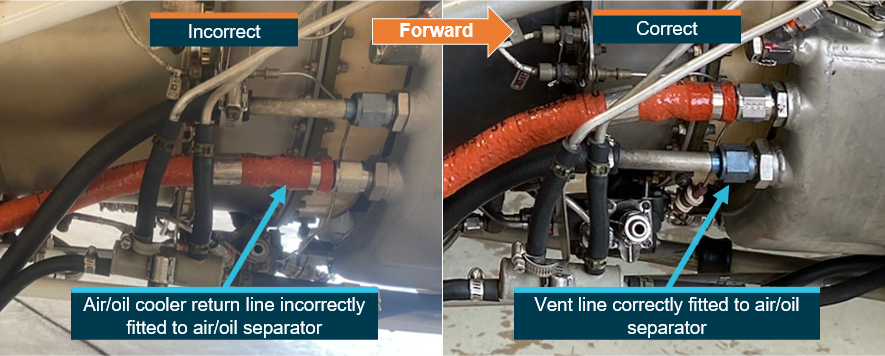Pilot Observes Abnormal Engine Indications During Flight on Cessna 441 Conquest II Turboprop

A Cessna 441 Conquest II turboprop aircraft, operating a charter flight in the Northern Territory, diverted after the pilot observed abnormal engine indications.
Later, the problem with the Cessna 441 Conquest II turboprop was found to be caused by oil lines that had been mistakenly transposed, an Australian Transport Safety Bureau (ATSB) investigation report notes.
On September 7, 2021, the twin-engined turboprop aircraft was flying from Sawfish Camp to Darwin with nine passengers on board.
During the cruise, the pilot observed abnormal torque fluctuations, as well as high oil pressure and high oil temperature indications, from the right TPE-331 engine.
The pilot diverted the aircraft to Tindal Airport and landed uneventfully, with maintenance checks identifying that the air/oil cooler return line and air/oil separator vent line had been incorrectly transposed during a recent engine change.
“The oil lines could be easily transposed, given they were long and flexible enough to each reach either port, and they were the same size, used the same thread, and were almost identical in appearance,” said ATSB Director Transport Safety Dr. Mike Walker.
Dr. Walker noted that since there was no record of which engineer had done the work, it was not possible to determine whether there were any individual or environmental factors associated with the error, or the extent to which the available maintenance documentation had been checked.
After the oil line issue was rectified, there were further abnormal indications from the right engine, during a flight about 3 weeks after the initial occurrence. After landing, the reduction gearbox scavenge pump was found to be unserviceable.
The ATSB’s final report notes the incorrect oil flow resulting from the transposed oil lines had damaged the engine’s air/oil separator, which then increased the reduction gearbox scavenge pump pressure. This compromised the structural integrity of the pump housing.
“These additional problems had not been detected during the initial maintenance,” Dr Walker noted.
The ATSB’s final report into the incident notes that in 1990 the engine’s manufacturer, Honeywell, issued a service information letter (SIL) advising the oil lines had been transposed on several previous occasions on similar aircraft.
Following this occurrence, the operator, Chartair, commenced a fleet-wide program to add markings to engine oil tanks, conducted toolbox talks with engineering staff about distractions during maintenance, and began documenting each stage of engine changes.
In addition, Honeywell reissued the SIL with additional information and guidance.
“This investigation highlights to maintenance engineers that it is important to check relevant documentation rather than relying on experience and memory, and to remain familiar with other data such as manufacturer service information letters,” Dr. Walker said.
“Further, since maintenance documents do not always provide advice on non-routine technical situations, operators and maintainers should seek technical advice from the manufacturer to ensure that nonroutine problems are fully rectified prior to releasing an aircraft to service.”
| Key points: – Cessna 441 charter flight diverted and landed safely after right engine malfunctioned; – Checks identified air/oil cooler return and air/oil separator vent lines had been incorrectly transposed during a recent engine swap; – ATSB reminds maintenance engineers to check relevant documentation, rather than relying on experience and memory. |
Read the full ATSB report: AO-2021-039 Engine malfunction involving Cessna 441, VH-JFU, 100 km north-east of Tindal Airport, Northern Territory, on 7 September 2021.
Content and photo source and credit: ATSB, “Engine malfunction after oil lines transposed.” Publication date: 02/2023. Final report: AO-2021-039 Engine malfunction involving Cessna 441, VH-JFU, 100 km north-east of Tindal Airport, Northern Territory, on 7 September 2021.
Sign up today for a Virtual 3-Day TapRooT® Root Cause Analysis Training Course . . .
. . . offered in these time zones — COT (Colombia), EST (NYC), PST (Seattle), CET (Paris), GST (Dubai), AWST (Perth). Other time zones may be offered as future virtual courses become available.
TapRooT®’s experts in incident facilitation, root cause analysis, and corrective actions can help your organization solve critical internal and external problems. When your company is in a situation that requires outside help, TapRooT®’s Root Cause Analysis experts can partner with your employees to identify and solve problems.
TapRoot® is global—and local—to meet your needs. If you would like us to teach a course at your workplace, please reach out here to discuss what we can do for you, or call us at 865.539.2139. Need other times or locations that you don’t see on today’s list? Please see our full selection of courses.



